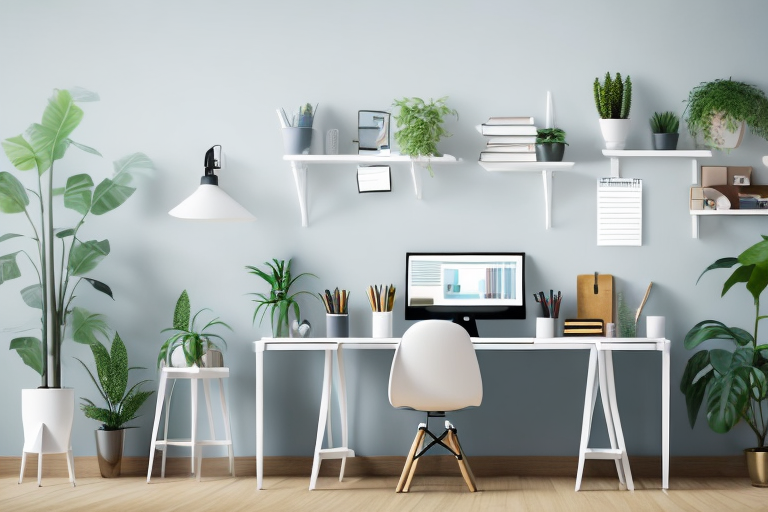10 Tips for Designing a Home Office
Working from home has become increasingly popular in recent years, and having a well-designed home office is essential for productivity and work-life balance. Whether you’re a freelancer, an entrepreneur, or someone who occasionally brings work home, designing a functional and inspiring home office is crucial. In this article, we will explore 10 tips to help you create the perfect home office environment.
Understanding the Importance of a Well-Designed Home Office
A well-designed home office can have a profound impact on your productivity. By creating a space specifically designed for work, you can minimize distractions, stay organized, and focus on your tasks more effectively. Additionally, a thoughtfully designed home office can enhance your work-life balance by providing a separate space for work, allowing you to mentally switch off when you step away from your desk.
Imagine walking into your home office and being greeted by a clean and clutter-free environment. Everything is in its place, neatly organized and within easy reach. Your desk is spacious, providing ample room for your computer, paperwork, and any other tools or equipment you may need. The walls are adorned with motivational quotes and artwork that inspire and energize you. The lighting is just right – not too bright to strain your eyes, but not too dim to make you feel sleepy. This well-designed space instantly puts you in the right mindset for work.
But it’s not just about aesthetics. A well-designed home office also takes into consideration the ergonomics of your workspace. Your chair is comfortable and provides proper support for your back. Your desk is at the right height, allowing you to maintain good posture and avoid unnecessary strain on your neck and shoulders. You have a separate area for your printer, scanner, and other peripherals, keeping them within reach but not cluttering up your main workspace.
The Impact on Productivity
When your workspace is tailored to your needs, it can significantly boost your productivity. A well-designed home office allows you to have everything you need within reach, reducing the time spent searching for supplies or documents. The layout of your office promotes efficiency, with designated areas for different tasks. For example, you have a dedicated area for brainstorming and a separate area for focused work. This organization helps you transition seamlessly between different types of work, eliminating the need to constantly rearrange your workspace.
Furthermore, a well-designed home office minimizes distractions. The space is soundproofed, reducing external noise that could disrupt your concentration. The walls are painted in soothing colors that promote a calm and focused atmosphere. You have a comfortable seating area where you can take short breaks and recharge, without the temptation of getting distracted by other activities in your home.
Enhancing Work-Life Balance
A properly designed home office can help create boundaries between your work and personal life. When you have a designated space for work, it becomes easier to mentally separate yourself from your professional responsibilities outside of designated work hours. This separation is vital for maintaining a healthy work-life balance and avoiding burnout.
Imagine stepping out of your home office at the end of the workday, closing the door behind you, and leaving your work behind. The physical separation between your work and personal space allows you to fully disconnect and focus on your personal life. You can engage in activities that bring you joy, spend quality time with your loved ones, and recharge your batteries without the constant reminder of unfinished tasks or looming deadlines.
Moreover, a well-designed home office can also contribute to your overall well-being. Natural light floods the room, providing a connection to the outside world and boosting your mood. Indoor plants add a touch of greenery and improve air quality, creating a healthier and more pleasant working environment. The overall ambiance of your home office promotes a sense of calm and tranquility, reducing stress and enhancing your overall well-being.
Starting Your Home Office Design Project
Before diving into the design process, it’s essential to identify your needs and choose the right space for your home office.
Creating a home office is an exciting endeavor that allows you to personalize your workspace and optimize productivity. Whether you’re a freelancer, a remote worker, or someone who enjoys pursuing hobbies at home, having a dedicated area for work or creative pursuits can make a significant difference in your overall well-being.
Identifying Your Needs
Think about the type of work you’ll be doing in your home office. Will you be primarily working on a computer, necessitating a spacious desk and comfortable chair? Or do you need enough room for crafting supplies or a drafting table? Understanding your needs will help you make informed decisions when selecting furniture and organizing your space.
Consider the tasks you’ll be performing on a daily basis and the tools and equipment you’ll require. If you’re a writer, you might need a quiet space with minimal distractions. On the other hand, if you’re an artist, you may need ample storage for your art supplies and enough room to spread out your work.
Additionally, think about your workflow and how you like to organize your work. Do you prefer having everything within arm’s reach, or do you thrive in a minimalist environment? Understanding your work style will help you design a home office that caters to your preferences and enhances your productivity.
Choosing the Right Space
Consider the available space in your home and choose a room or area that best suits your needs. Ideally, your home office should be located away from distractions and noise. Look for a spot with ample natural light and good ventilation to create a pleasant and energizing work environment.
If you have multiple options for your home office location, think about the proximity to other areas of your home. Having your office near the kitchen or living room might be convenient for quick breaks or easy access to snacks, but it could also lead to distractions. On the other hand, having your office in a separate room or a quiet corner of your home can help you maintain focus and separate your work life from your personal life.
Consider the layout and size of the space you choose. Will it accommodate all the furniture and equipment you need? Is there enough room for you to move around comfortably? Take measurements and create a floor plan to visualize how everything will fit together. This will help you make informed decisions when it comes to purchasing furniture and arranging your workspace.
Remember, your home office should be a place where you feel inspired and motivated. Take the time to create a space that reflects your personal style and preferences. Add elements that make you happy, such as artwork, plants, or personal mementos. By creating a space that you love, you’ll be more likely to enjoy spending time in your home office and be productive.
Essential Elements of a Home Office
Now that you have a clear idea of your needs and have chosen a suitable space, it’s time to furnish and equip your home office with the essentials.
The Right Furniture
Investing in a quality desk and chair is crucial for your comfort and productivity. Look for ergonomic designs that support proper posture and offer adjustable features. Additionally, consider storage options such as shelves, drawers, and filing cabinets to keep your workspace organized and clutter-free.
Lighting and Ventilation
Proper lighting is essential in a home office. Position your desk near a window to take advantage of natural light. Supplement it with task lighting, such as a desk lamp, to reduce eye strain. Adequate ventilation is also crucial for a comfortable working environment, so ensure proper air circulation.
Personalizing Your Home Office
Your home office should reflect your personal style and create a space where you feel inspired to work. Take the time to add personal touches and make it feel welcoming.
Choosing a Color Scheme
Consider the psychological impact of different colors when choosing a color scheme for your home office. Depending on your work, you may opt for soothing colors like blues and greens, or energizing tones like yellows and oranges. Ultimately, choose colors that evoke positive emotions and help create the desired atmosphere.
Incorporating Personal Touches
Display items that inspire you or remind you of your goals and achievements. This could include artwork, photographs, or motivational quotes. Keep in mind that personal touches shouldn’t be excessive or distracting. Finding a balance between a professional workspace and a personalized environment is key.
Organizing Your Home Office for Efficiency
To maintain productivity and avoid clutter, it’s important to develop efficient organizational systems in your home office.
Storage Solutions
Invest in storage solutions that optimize your space and help keep your belongings organized. Consider using shelves, baskets, or storage bins to categorize and store items efficiently. Keeping your workspace tidy will create a clear and focused work environment.
Cable Management
With multiple electronics in your home office, cable management is crucial to keep your workspace clean and safe. Use cable clips or organizers to keep your cables neatly organized and hidden from view. This not only improves the overall aesthetic but also reduces the risk of accidents caused by tangled cords.
By following these 10 tips for designing a home office, you can create a workspace that enhances productivity, promotes work-life balance, and reflects your personal style. Remember to adapt these tips to your specific needs to create a space where you can thrive professionally and enjoy the benefits of working from home.



